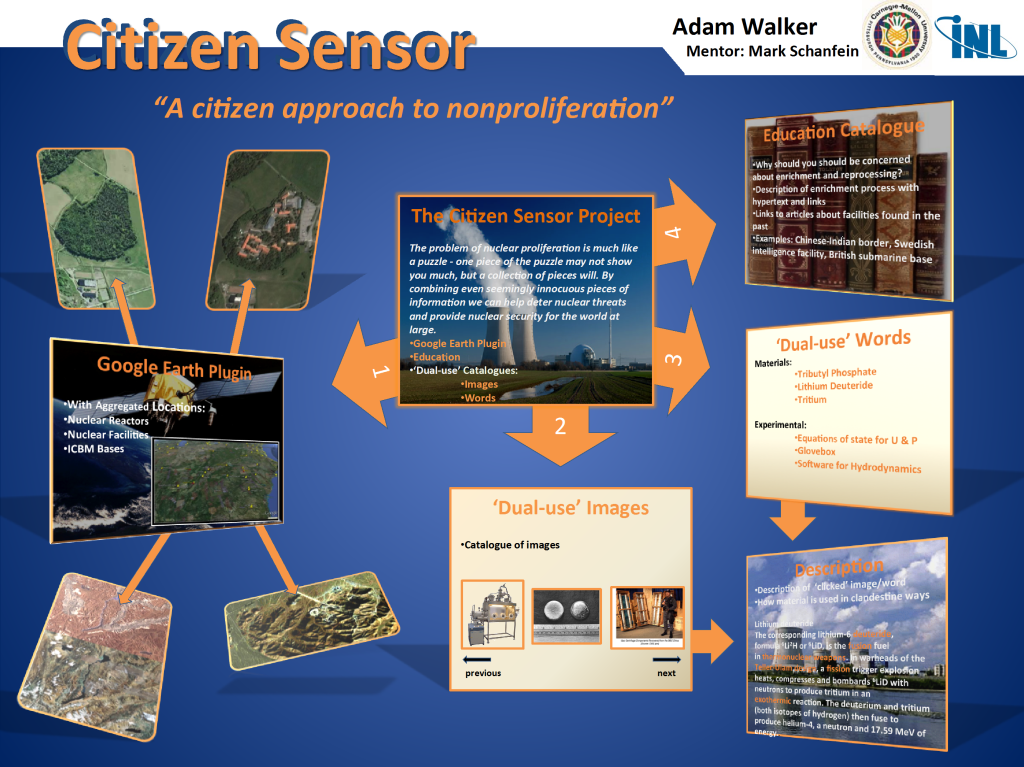
A Citizen Approach to Nonproliferation
Have you ever watched a football match where thousands of attendees witness an event that the officials missed? Sometimes there is wisdom in the crowd, especially a crowd who understand the rules of the game. Officials, no matter how dedicated and hardworking they may be, cannot be everywhere or look everywhere at every moment. Indeed, sometimes just one set of eyes can call attention to what should have been obvious or would have been missed.
Consider the individual with administrative responsibilities working for an import/export company who has been told that the company works on the acquisition of farming equipment. Invoices and shipment information cross their desk for large diameter carbon fiber tubes or those made from maraging steel or high-speed electronics, potential items for a gas centrifuge uranium enrichment facility or nuclear weapons detonation fire sets. Maybe they are laborers in the company’s receiving facility and are responsible for uncrating and repackaging these purchases. They are witnesses to illegal activities and, if they remain uninformed, these individuals would simply go about their everyday tasks.
Shouldn’t we consider a way to reach the citizens of the world to make the world a safer place? Shouldn’t we explore how the power of the web and crowdsourcing might have a profound impact in the area of nonproliferation? Part of the power of the web is how inexpensive it is to explore concepts and allow users to vote with their participation and support.
This article describes the concept of Citizen Sensor1, which aims at leveraging citizens around the world to further strengthen the nonproliferation and international safeguard regime. Start by imagining a world with new and inexpensive methods of vigilance against the spread of nuclear weapons by producing as many knowledgeable citizens as possible – using the observations of crowds and attentive individuals through the power of the web.
The detection of undeclared nuclear facilities and nuclear weapons programs is unequivocally the greatest challenge facing the International Atomic Energy Agency. The common theme for all nuclear nonproliferation challenges is the exposure of people to information, but they are often unaware of the actual application or nature of their work or of the items and activities they see. Or, even if they are aware, they are not sure where to turn to or how to safely inform others. By using the web as both an education tool and a reporting platform, Citizen Sensor aims to alert them to this type of threat, instruct them on how they can help with early detection through education and vigilance and share their knowledge to try to deter those who seek to create a nuclear weapon or other weapons of mass destruction. From the proposed website: “The problem of nuclear proliferation is much like a puzzle – one piece of the puzzle may not show you much, but a collection of pieces will. By combining even seemingly innocuous pieces of information we can help deter nuclear threats and provide nuclear security for the world at large.”
Elements of the Internet-based Citizen Sensor Culture
A variety of potential elements could influence the creation of the Citizen Sensor. These include:
- Proliferation indicator training – What are the most important signs that might indicate proliferation is happening and how do you watch for them? Citizen Sensor would educate the web-based community as a formidable mechanism for early detection of the construction of clandestine nuclear facilities and discovery of weaponization activities. The website would allow education through words and pictures.
- “Neighborhood Watch” as a sharing platform – Post your evidence/suspicions anonymously or signed for discussion and analysis by the crowd.
- “Amber” or “911” type alert for urgent real-time events – If nuclear or radiological material or sensitive information goes missing, mobilize people to help law enforcement find them.
- “Suggestion” box – What are your ideas on how to improve a Citizen Sensor website?
- Testimonials – What supporting activities can be shared with the general public in order to encourage this work?

The concept of Citizen Sensor reaches beyond its website; it would leverage information and capabilities on other websites (such as the IAEA, Google Earth, and Wikipedia) and it will develop an international culture of informed training, watchfulness, and reflection regarding proliferation, coupled with statistical and social science analysis of the information exchanges and discussions that transpire.
Citizen Sensor would include tools for education, information discovery, and anonymous reporting, and could serve as a test bed for other researchers to experiment with specific data processing and social science techniques. These include incentives for the public to participate and methods to screen for incorrect information.
Training modules on all elements of the nuclear fuel cycle, single/dual use items, and aspects of weaponization would be developed, along with search tools to allow users to discover any linkages/matches from their “found” information to be translated into written and/or visual knowledge.

A successful Citizen Sensor website would catalyze a watchful and credible culture of citizen sensors – a worldwide community that produces potential actionable threats and concerns that those with authority and power would consider and act upon. It could be a significant deterrent to proliferators, as it targets the very human resources they count on.
As smart phones continue to grow in computational and sensor capability, new applications continue to arise. GammaPix™ works with the camera of iPhones2 and Android-based3 smart phones to detect radioactivity. The app allows you to measure radioactivity levels wherever you are and determine if your local environment is safe. The app can be used for the detection of radioactivity in everyday life such as exposure on airplanes, from medical patients, or from contaminated products. GammaPix™ can also be used to detect hazards resulting from unusual events like nuclear accidents (such as Fukushima), a terrorist attack by a dirty bomb, or quietly placed and potentially dangerous radioactive sources. As this technology becomes more widespread, a way to gather, process, and post the information is needed. Educating the public on its limitations is just as important as its capabilities, and Citizen Sensor website could potentially accomplish both aspects.
If Citizen Sensor had already been operational, perhaps it could have helped during the 2013 theft in Mexico of a cobalt-60 radioactive source. The thieves apparently had not been aware of what they had stolen, but what if they had been interested in making a radiological dispersal device? Just as an Amber Alert aims to help officials find a missing child or a 911 call is used for emergencies in the United States, perhaps a Citizen Sensor alert could help find missing radioactive materials.
Through the Comprehensive Test Ban Treaty Organization, the world is building a surveillance network to detect nuclear tests. According to an article in the Washington Post, “the nearly-completed International Monitoring System is proving adept at tasks its inventors never imagined. The system’s scores of listening stations continuously eavesdrop on Earth itself, offering clues about man-made and natural disasters as well as a window into some of nature’s most mysterious processes.”4 What might thousands of people, educated observers, and radioactivity-detecting smart phones find?
Requirements
Citizen Sensor must be as open as possible, without any government affiliation, by hosting through a non-governmental organization. It must be unencumbered by government policy and/or regulations. It must be responsive to current events and actively maintain updated information. Knowledgeable developers of websites and training modules for nuclear fuel cycle facilities, proliferation indicators, and sustained funding are all key factors for any chance of success.
The effort must be international and multi-lingual with capabilities that evolve over time as experience and suggestions drive its future. Contributions can be either public posts or private messages and can be either anonymous or signed. It is certain there will be false positives, and issues and concerns that do not point to proliferation activity. Both the culture and software must be structured to minimize false positives and protect it and contributors from the ramifications of false positives. It will also act as a nexus for discovery tools at other websites offering maps, images, knowledge, and analysis tools.
The challenge that is faced is the support (financial and skills) to make this concept a reality. This includes recruiting scientific talent to populate educational modules, website creation and operators and methods to promote the Citizen Sensor and its potential to educate citizens about the nature of nuclear materials and proliferation.
Editor’s Note
If interested, please send feedback and ideas to citizensensor@inl.gov.
Mark Schanfein joined Idaho National Laboratory (INL) in September 2008, as their Senior Nonproliferation Advisor, after a 20-year career at Los Alamos National Laboratory where, in his last role, he served as Program Manager for Nonproliferation and Security Technology. He served as a technical expert on the ground in the DPRK during the disablement activities resulting from the 6-Party Talks. Mark has eight years of experience working at the International Atomic Energy Agency in Vienna, Austria, in the Department of Safeguards where he served four years as a safeguards inspector and as Inspection Group Leader in Operations C, and four years as the Unit Head for Unattended Monitoring Systems (UMS) in Technical Support. In this position he was responsible for the installation of all IAEA unattended systems in nuclear fuel cycle facilities worldwide.
With over 30 years of experience in international and domestic safeguards, his current focus is on conducting R&D to develop the foundation for effective international safeguards on pyroprocessing facilities and solutions to other novel safeguards challenges.
Steven Piet has worked 31 years at Idaho National Laboratory. He earned the Bachelors, Masters, and Doctor of Science degrees in nuclear engineering from the Massachusetts Institute of Technology (MIT). He has 57 peer-reviewed journal articles and is author or co-author of 3 book chapters – in the fields of nuclear fuel cycles, fusion safety and technology, environmental science and decision making, and stakeholder assessment and decision making. For the nuclear fuel cycle program, he framed questions, searched for broadly acceptable and flexible solutions, promoted consensus on criteria, evaluated trade-offs, and identified R&D needs and possibilities to improve concepts; and was responsible for development of the world-leading multi-institution fuel cycle system dynamic model VISION. For the Generation IV advanced nuclear power program, his lab-university team diagnosed public/stakeholder issues and heuristics.
He has also been a Toastmaster for almost 9 years and has attained the educational achievement level of “Distinguished Toastmaster,” which less than 1% of Toastmasters achieve. As Club President, his club achieved President’s Distinguished Status. He was recognized as Area Governor of the year (2011-2012) and Division Governor of the year (2012-2013) and now serves as District Lt Governor of Marketing.
The Federation of American Scientists applauds the United States for declassifying the number of nuclear warheads in its military stockpile and the number of retired and dismantled warheads.
North Korea may have produced enough fissile material to build up to 90 nuclear warheads.
Secretary Austin’s likely certification of the Sentinel program should be open to public interrogation, and Congress must thoroughly examine whether every requirement is met before allowing the program to continue.
Researchers have many questions about the modernization of Pakistan’s nuclear-capable aircraft and associated air-launched cruise missiles.